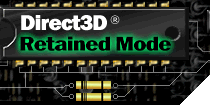



Index
Topic Contents
Previous Topic: IDirect3DRMTexture2
Next Topic: IDirect3DRMViewport
 |
 |

|
 |
| |||
| |||
IDirect3DRMUserVisual
Applications use the IDirect3DRMUserVisual interface to initialize Direct3DRMUserVisual objects. Note that this initialization is not necessary if the application uses the IDirect3DRM::CreateUserVisual method; it is required only if the application uses the IDirect3DRM::CreateObject method to create the user-visual object. This section is a reference to the methods of this interface. For a conceptual overview, see IDirect3DRMUserVisual Interface.
The IDirect3DRMUserVisual interface supports the Init method.
The IDirect3DRMUserVisual interface, like all Component Object Model (COM) interfaces, inherits the IUnknown interface methods. The IUnknown interface supports the following three methods:
AddRef QueryInterface Release In addition, the IDirect3DRMUserVisual interface inherits the following methods from the IDirect3DRMObject interface:
AddDestroyCallback Clone DeleteDestroyCallback GetAppData GetClassName GetName SetAppData SetName The Direct3DRMUserVisual object is obtained by using the IDirect3DRM::CreateUserVisual method.
IDirect3DRMUserVisual
IDirect3DRMUserVisual::Init
Initializes a Direct3DRMUserVisual object.
HRESULT Init(
D3DRMUSERVISUALCALLBACK d3drmUVProc,
void * lpArg
);Parameters
- d3drmUVProc
- Application-defined D3DRMUSERVISUALCALLBACK callback function.
- lpArg
- Application-defined data to be passed to the callback function.
Return Values
Returns D3DRM_OK if successful, or an error otherwise. For a list of possible errors, see Direct3D Retained Mode Return Values.
Remarks
Applications can use the IDirect3DRM::CreateUserVisual method to create and initialize a user-visual object at the same time. It is necessary to use IDirect3DRMUserVisual::Init only when the application has created the user-visual object by using the IDirect3DRM::CreateObject method.
© 1998 Microsoft Corporation. All rights reserved. Terms of Use.